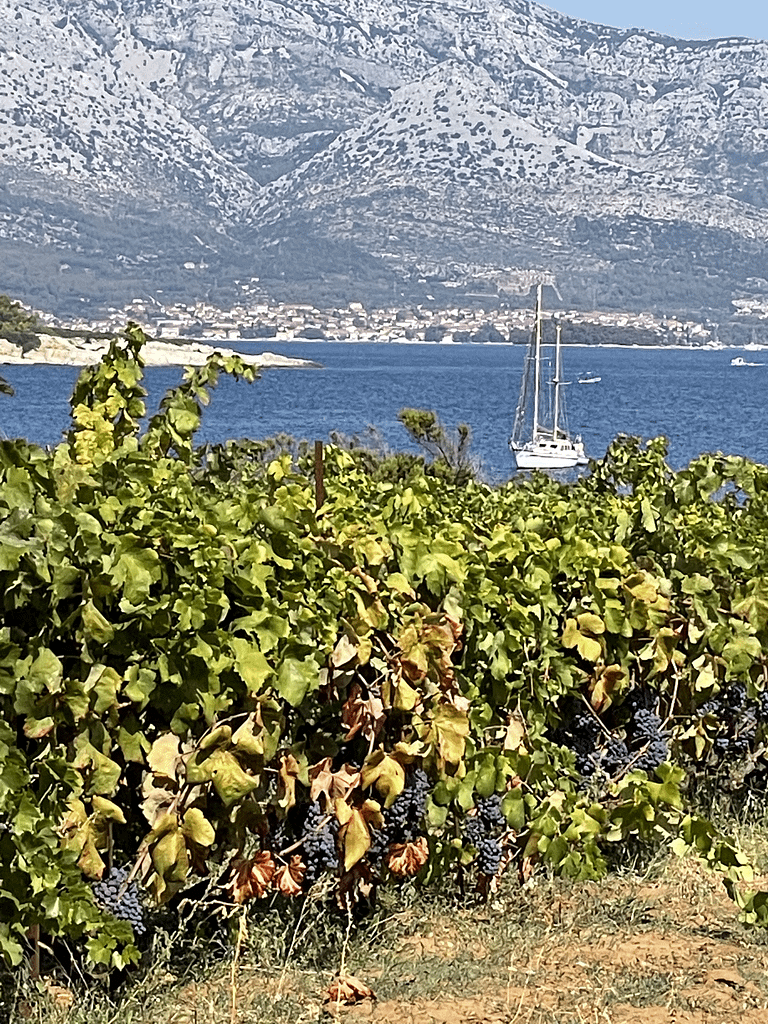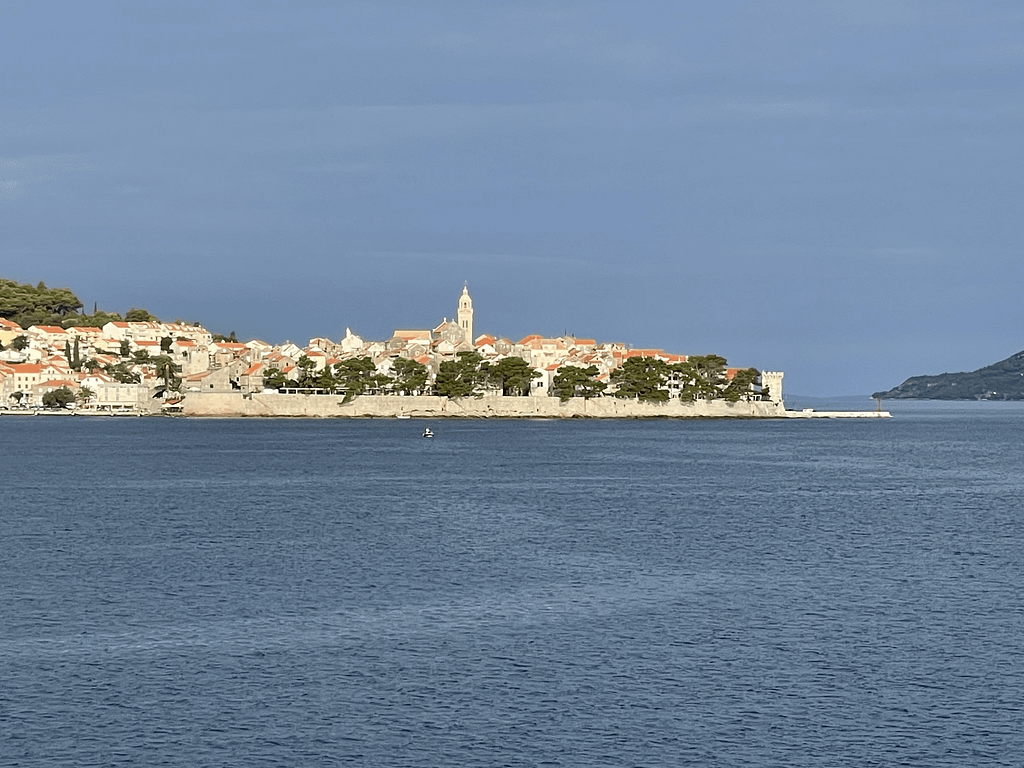Places Along this Wine Trail to Explore
To Begin
There are essentially three ways to get to Korčula Island, all by ferry boat (check updated schedules at the Croatian Government operated Jadrolinija):
- From Split, there are both passenger-only (most often via a stop on Hvar) and passenger/car ferries. Both typically land in Vela Luka (the main harbor on the island, located on the western side of the island opposite from Korčula town)
- From Dubrovnik, passenger-only ferries to Korčula town
- From Split or Dubrovnik driving through the Pelješac Peninsula to the short ferry ride from Orebič — making it the shortest trip across the water.

Both passenger-only and passenger/car ferries shuttle between Orebič and Korčula town.

The passenger-only will disembark at the old town Korčula but the car ferry drops at a terminal between Korčula town and Lumbarda. The road straight from the terminal will lead to a T intersection – straight will take you to Korčula town and beyond to the rest of the island, to the left is the short drive to Lumbarda.
From Vela Luka on the far western edge of the island, the main highway that bisects the island’s length will take you first to Blato, then off that main highway to the side roads to Smokvica and Čara. Back to the main highway to the east will take you past Korčula town to a right turn to end up in Lumbarda.
Korčula Island
Korčula island is the birthplace of the well-known white wine Pošip – discovered and first cultivated in the center of the island near Čara and Smokvica. The story told is that a farmer in the woods near Čara discovered a wild grape vine and began cultivating the variety. Pošip is now one of the most produced and popular white wines in all of Croatia.

On Korčula island, the rare and desirable Grk – likely given its more stringent requirements to cultivate – is the much lesser known of the two varieties and produced at reduced volumes. Pošip, Grk and Plavac Mali are the main varieties to be explored on this Croatian Wine Trail.
Lumbarda
Lumbarda is a picturesque seaside village of two coves surrounded by water front homes and a few restaurants. Kayaking and swimming are activities that abound here, along with wine tasting. A sandy beach exists past Lumbarda through vineyards of Grk grapes, a sunny stopover on the Croatian Wine Trail.
Grk was originally grown and most of the vineyards are still near Lumbarda. It is said that Grk vines grow best in the rocks and sand next to the water’s edge just outside Lumbarda. Legend goes that the vine absorbs the sea salt in the air giving it the unique crisp, fruity and slightly briny taste. This variety grows only as a female plant, and so requires nearby vines of another variety for pollination. Typically, the classic red wine variety Plavac Mali is planted in a certain ratio of vine-to-vine in order to cajole the Grk vines to produce fruit.
(Read more about the Grk grape and its history here)
In Lumbarda, there are a handful of wineries that produce a limited quantity of Grk – prominent among these being Biré Winery (Zure and Cipre are two others in Lumbarda).

Look for the Biré sign off the main road to the right (and then about 1-2 km). Bire’s Grk has tones of citrus on the nose and hints of seagrass and stone fruit on the mouth. Dry but fruity, it is served refreshingly chilled and sparkles with flavor.

If you want a true “garage wine” experience, head uphill in the residential neighborhood beyond Biré and look for a small sign and tasting room for Cipre on the right – with sweeping views of Lumbarda and the nearby islands from this modest but proud family-owned and operated winery.
Čara
Heading out of Lumbarda and past Korčula town, the main highway delivers you to the center of the island. Beyond Pupnat, the road sign to Čara (to the left) will direct you to a scenic byway through the hills and valleys of the central wine growing region on the island.
Through the narrow streets of Čara, be watchful for the post office on the left, turn left there (the sign will be to Zavalatica). There in the near distance is a large winery, Pošip PZ Čara, just beyond the vineyards in this valley below the village. While the tasting room is somewhat bare and utilitarian (with a good outdoor terrace), the native white wine Pošip here is full-bodied, with intense aromas and flavors of dried apricot and fig.

Smokvica
Back to Čara, turn left in the village and head to Smokvica, just a short drive along the same scenic byway. On the far side of Smokvica, look for the Merga Victa buildings on the right.

This is the best tasting room, inside and out, on Korčula.

Wines produced here are under the Black Island Winery name and bear the labels Merga Victa, Dalmatian Dog and Radovanovič.
Their signature wine is the Merga Victa Pošip Sur Lie, and Plavac Mali made here is less tannin-like than on the Pelješac Peninsula.

But the hidden gem, in our humble opinion, is Grk.
This rare varietal, once exclusive to Lumbarda, is now being cultivated inland on the island under the Radovanovič label – crafted by the very talented winemaker Igor Radovanovič. The difference between the seaside vineyards and those produced here in the heart of Pošip country is subtle but distinct. Radovanovič Grk has an increase in effervescence that delights the palate. On the nose, it has hints of nectarine, peaches and grapefruit with flavors of apricot and green apple on taste.

Combining Grk with shellfish is a must. A bowl of mussels and a bottle of Grk may be the most sublime of Croatian wine and food pairings.

With bread, olive oil and dry cheese, one has a meal befitting of the best of Dalmatia’s islands. The nearby seaside village of Brna is a find and worth a stopover, and the little Konobas (taverns) there will serve local wine and food pairings.
Blato
From Black Island Winery tasting room at Smokvica, turn right to the north and west to return to the main highway and follow the signs to Blato. A beautiful tree lined narrow street greets travelers to Blato in this active, small Croatian village. Blato 1902 Winery – like the name implies — has been making wine and olive oil here for decades. Known as much for their olive oil as wine, a tasting of both is warranted. Try the Marco Polo olive oil label. Their dedicated wine and olive oil shop with cheese/prosciutto (prśut) offerings along with olive oil and wine tasting is located mid-way on this tree lined street on the right (or north side).
Beyond Blato is a true, family-owned wine experience in an obscure and breathtakingly beautiful sea cove on the island’s north side. The Bačić Winery is found by following the signs to Prigradica from the western side of Blato. Head to the ocean and once in Prigradica, go west again keeping the water to your right. A winding road will deliver you to Crna Luka, a small, photo-worthy cove with Bačić Winery sitting prominently above the sea.

Incredibly, the family Bačić has farmed their land on Korčula for 700 years.

Sister and brother Mirta and Petra Bačić now run the family wine business and serve up delightful red and white blends (of the whites, try Cetinka and Kalina), in a setting that warrants a chunk of time to appreciate.

For an agrotourism experience, there are three no-frills apartments for rent above the wine tasting terrace, each with a kitchenette – no restaurant here so pack your lunch and experience the relaxed and authentic Korčula island seaside.

(Visit Vinarija Bačić’s website here for more information)


